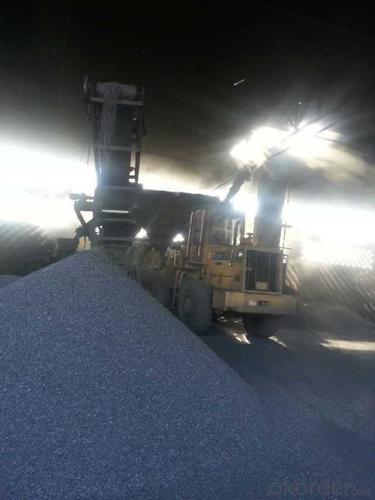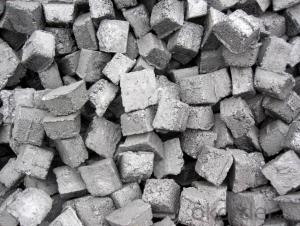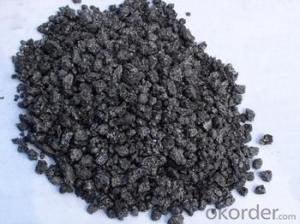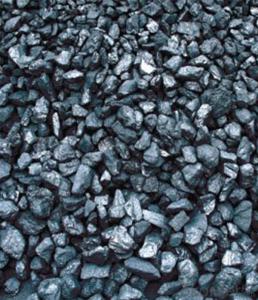FC 95% Calcined Anthracite
- Loading Port:
- China Main Port
- Payment Terms:
- TT OR LC
- Min Order Qty:
- -
- Supply Capability:
- -
OKorder Service Pledge
OKorder Financial Service
You Might Also Like
Specifications
Calcined Anthracite
Fixed carbon: 90%-95%
S: 0.5% max
Size: 0-3. 3-5.3-15 or as request
Calcined Anthracite is produced using the best Anthracite-Taixi Anthracite with low S and P, It is widely used in steel making and casting, Chemical and some other fields.
General Specification of Calcined Anthracite:
PARAMETER UNIT GUARANTEE VALUE | |||||
F.C.% | 95MIN | 94MIN | 93MIN | 92MIN | 90MIN |
ASH % | 4MAX | 5MAX | 6MAX | 7MAX | 8MAX |
V.M.% | 1 MAX | 1MAX | 1.5MAX | 1.5MAX | 1.5MAX |
SULFUR % | 0.5MAX | 0.5MAX | 0.5MAX | 0.5MAX | 0.5MAX |
MOISTURE % | 0.5MAX | 0.5MAX | 0.5MAX | 0.5MAX | 0.5MAX |
Size can be adjusted based on buyer's request.
Pictures of Calcined Anthracite:


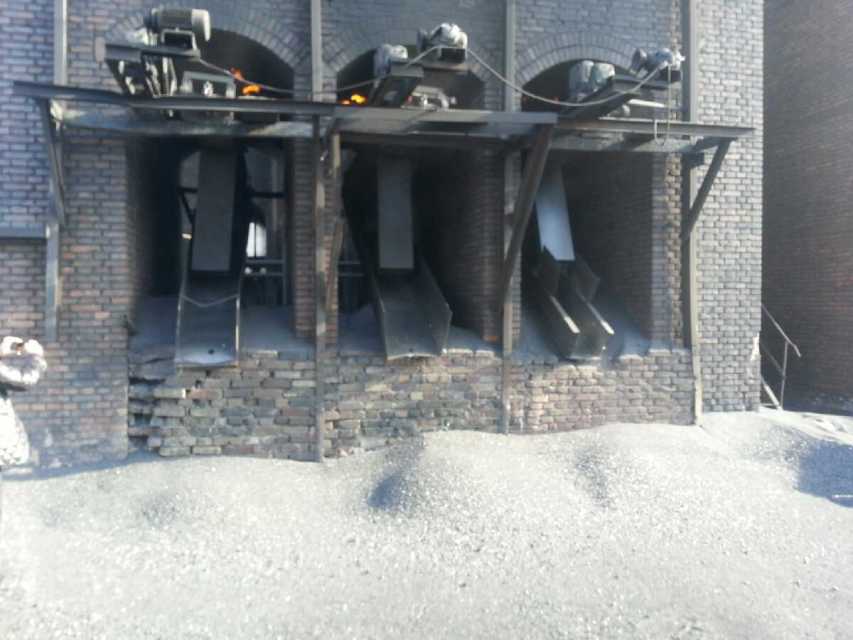
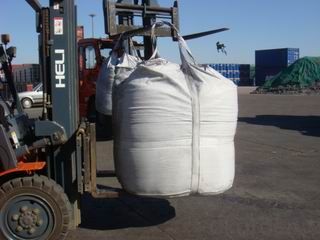
We can supply below furnace charges, please feel free to contact us if you areinterested in any of any of them:
Coke (Metallurgical, foundry, gas)
Calcined Anthracite with fixed carbon from 90% to 95%
- Q: Appearance, hardness, electrical conductivity, use of carbon 60
- C60 does not normally conduct electricity because C60 is so large that it can put other atoms into it and affect its physical properties, so it cannot be electrically conductiveUsed to strengthen metalImprove the metal material strength by alloying, plastic deformation and heat treatment, one of the ways to strengthen the interaction through geometry, such as coke carbon dispersed in the metal, carbon and metal exchange position in the crystal lattice, can cause plastic deformation of metal, carbon and metal carbide particles that can make the metal enhanced. In the enhancement of metal materials, the effect of C60 ratio of carbon in coke is better, this is because the C60 is higher than the smaller particles, active carbon, particle size of C60 with metal carbide dispersion effect is 0.7nm, and the particle size of carbon and metal carbide dispersion effect the body is 2 m ~ 5 m, has a larger difference in enhancing the role of the metal.Used as a new catalystIn C60, the electronic structure of chemists began to explore the possibility of.C60 catalyst for C60 with olefin, with transition metal (such as platinum and nickel metal) to form a series of complexes. For example C60 and platinum, osmium can be combined into {[(C2H5) 3P]2Pt}C60 and C60OsO4 (four butylpyridine) and other coordination compounds and they are likely to become the efficient catalyst.Japanese researchers Toyohashi University of science and technology of the synthesis of highly catalytic activity of palladium Pt synthesis researchers and C60 compound C60Pd6. China Wuhan University (PPh3) 2C60 (PPh3 three, triphenylphosphine) for hydrosilylation reaction with high catalytic activity.
- Q: What are the different allotropes of carbon?
- The different allotropes of carbon include diamond, graphite, graphene, carbon nanotubes, and fullerenes.
- Q: What are the properties of carbon-based textiles?
- Carbon-based textiles offer several distinct advantages in different applications. To begin with, they demonstrate exceptional strength and durability. Renowned for their high tensile strength, carbon-based textiles can resist stretching and tearing, enabling them to withstand harsh conditions and maintain their integrity over time. Moreover, these textiles possess excellent thermal conductivity, efficiently managing heat. This quality proves beneficial in industries like aerospace, automotive, and electronics, where effective heat dissipation is crucial to prevent system failures. Additionally, carbon textiles exhibit remarkable resistance to chemical corrosion, remaining structurally intact even when exposed to various chemicals, acids, and solvents. This resistance makes them ideal for applications in the chemical industry, where contact with corrosive substances is common. Another notable attribute of carbon textiles is their inherent flame resistance. They possess a high resistance to ignition and do not easily propagate flames. Consequently, they find use in environments where fire safety is paramount, such as protective clothing for firefighters and military personnel. Furthermore, carbon-based textiles display good electrical conductivity, making them suitable for electronics and electrical engineering applications. They effectively conduct electricity and dissipate static charges, reducing the risk of electrical malfunctions or damage. Lastly, carbon textiles have a low coefficient of thermal expansion, meaning they undergo minimal expansion or contraction with temperature changes. This property ensures their dimensional stability, guaranteeing that they maintain their shape and size under varying thermal conditions. In conclusion, carbon-based textiles possess a combination of strength, durability, thermal conductivity, chemical resistance, flame resistance, electrical conductivity, and dimensional stability. These properties render them highly versatile and suitable for a wide range of applications across various industries.
- Q: What are some common compounds of carbon?
- Carbon forms a wide range of compounds due to its unique ability to bond with other carbon atoms and a variety of other elements. Some common compounds of carbon include carbon dioxide (CO2), methane (CH4), ethanol (C2H5OH), ethene (C2H4), acetic acid (CH3COOH), and glucose (C6H12O6). These compounds are essential in various fields such as biology, chemistry, and industry. For example, carbon dioxide is a greenhouse gas that plays a crucial role in the Earth's climate system, methane is a potent greenhouse gas released during natural gas production and contributes to climate change, ethanol is a common alcohol used as a fuel and solvent, ethene is used to produce plastics, acetic acid is a key component in vinegar, and glucose is a primary source of energy for living organisms. These compounds highlight the versatility and importance of carbon in the world around us.
- Q: How does carbon dioxide affect climate change?
- Carbon dioxide (CO2) is a greenhouse gas that plays a significant role in climate change. When released into the atmosphere through natural processes like volcanic eruptions or human activities such as burning fossil fuels, CO2 traps heat from the sun and prevents it from escaping back into space, leading to a phenomenon known as the greenhouse effect. The increased concentration of CO2 in the atmosphere due to human activities, primarily the burning of fossil fuels like coal, oil, and natural gas, has led to an imbalance in the natural carbon cycle. This imbalance has resulted in a rapid increase in global CO2 levels, contributing to the warming of the Earth's surface and the subsequent changes in climate patterns. Since the Industrial Revolution, the burning of fossil fuels has caused a significant rise in atmospheric CO2 levels, increasing the Earth's average temperature. This rise in temperature affects various aspects of the climate system, leading to a range of impacts. One of the most evident consequences of increased CO2 levels is the rise in global temperatures. This temperature increase leads to the melting of glaciers and polar ice, causing sea levels to rise. Rising sea levels pose a threat to coastal areas and low-lying islands, resulting in increased flooding, coastal erosion, and the potential displacement of communities. Furthermore, elevated CO2 levels contribute to more frequent and intense heatwaves, droughts, and wildfires in many regions. These extreme weather events can have detrimental effects on agriculture, water availability, and human health. Carbon dioxide also affects the balance of ecosystems by altering the growth patterns and distribution of plant and animal species. Changes in temperature and precipitation patterns, driven by increased CO2 levels, disrupt the delicate web of life, leading to the loss of biodiversity and the potential extinction of certain species. To mitigate the impacts of CO2 on climate change, reducing greenhouse gas emissions is crucial. Transitioning to renewable energy sources, improving energy efficiency, and adopting sustainable practices are some of the steps that can help reduce CO2 emissions and limit the extent of climate change. Additionally, efforts to restore and protect forests and other natural carbon sinks can help absorb and store CO2, mitigating its effects on the climate.
- Q: What are the impacts of carbon emissions on the stability of permafrost?
- Carbon emissions have a significant impact on the stability of permafrost. Permafrost refers to the layer of soil, sediment, and rock that remains frozen for at least two consecutive years. It covers vast areas in the Arctic, subarctic regions, and high-altitude mountain ranges. One of the main impacts of carbon emissions on permafrost stability is the acceleration of climate change. Carbon dioxide (CO2) and other greenhouse gases trap heat in the atmosphere, leading to global warming. As temperatures rise, permafrost starts to thaw, causing a range of negative consequences. Thawing permafrost releases large amounts of stored carbon into the atmosphere. This carbon was previously locked in the frozen organic matter, such as dead plants and animals, which accumulated over thousands of years. As permafrost thaws, microbes decompose this organic matter and release greenhouse gases like carbon dioxide and methane. These emissions create a positive feedback loop, further exacerbating climate change and leading to more permafrost thawing. The release of carbon from thawing permafrost contributes to the overall increase in atmospheric greenhouse gas concentrations. This, in turn, amplifies global warming and global climate change. The impacts are not limited to the Arctic; they affect the entire planet. Rising temperatures, sea-level rise, extreme weather events, and disruptions to ecosystems are some of the consequences of global climate change. Permafrost thaw also affects infrastructure and human settlements in the Arctic and subarctic regions. Buildings, roads, pipelines, and other infrastructure built on permafrost can be destabilized as the ground beneath them softens. This can lead to structural damage and economic losses. Additionally, communities that rely on permafrost for traditional activities such as hunting, fishing, and transportation face challenges as the landscape changes. The impacts of carbon emissions on permafrost stability are not only local but also global. The release of stored carbon from permafrost contributes to climate change, which has far-reaching consequences for ecosystems, economies, and societies worldwide. It is crucial to reduce carbon emissions and mitigate climate change to preserve permafrost and its vital role in the Earth's climate system.
- Q: What are the properties of carbon-based adhesives?
- Carbon-based adhesives have several properties that make them versatile and widely used in various industries. Firstly, carbon-based adhesives are known for their excellent bonding strength. They have the ability to create strong and durable bonds between different materials, including metals, plastics, ceramics, and composites. This makes them suitable for applications where a reliable and long-lasting bond is required. Another important property of carbon-based adhesives is their high temperature resistance. They can withstand extreme temperatures without losing their adhesive properties, making them ideal for applications in high-temperature environments. This property also allows carbon-based adhesives to be used in industries such as aerospace and automotive, where components are subjected to elevated temperatures. Carbon-based adhesives also possess good chemical resistance, meaning they can withstand exposure to various chemicals without degradation. This property makes them suitable for use in industries where adhesives may come into contact with solvents, fuels, or harsh chemicals. Additionally, carbon-based adhesives exhibit excellent electrical conductivity. This property allows them to be used in applications where electrical or thermal conductivity is required, such as in the electronics industry. Furthermore, carbon-based adhesives often have low shrinkage and low outgassing characteristics. This means that they do not significantly change in size or release volatile substances during curing, minimizing the risk of damage or contamination to surrounding materials. Overall, carbon-based adhesives offer a combination of high bonding strength, temperature resistance, chemical resistance, electrical conductivity, and dimensional stability, making them a preferred choice in various industries where reliable and durable bonding solutions are needed.
- Q: What is the concept of carbon equivalent? What is the relationship between carbon equivalent and weldability?
- In order to facilitate the expression of strength properties of these materials and welding performance simply to carbon equivalent to said through the statistics of test data.
- Q: What type of carbon copy sheet can be printed on? How many copies?
- Printed in carbon free carbon paper, usuallyUpper: whiteMedium: RedNext: yellowMainly depends on how much you want to print. Generally 100 pages, such as:One copy of the two couplet is 50 copies.One copy of the triad is 33 copies.One copy of the quadruple is 25 copies.This is a five of the 20.
- Q: What are the problems that should be paid attention to in the injection molding of the material? Who has some details about carbon fiber injection? Thank you for sharing
- You can go directly to the Chinese HowNet or the census, there should be some.
Send your message to us
FC 95% Calcined Anthracite
- Loading Port:
- China Main Port
- Payment Terms:
- TT OR LC
- Min Order Qty:
- -
- Supply Capability:
- -
OKorder Service Pledge
OKorder Financial Service
Similar products
Hot products
Hot Searches

